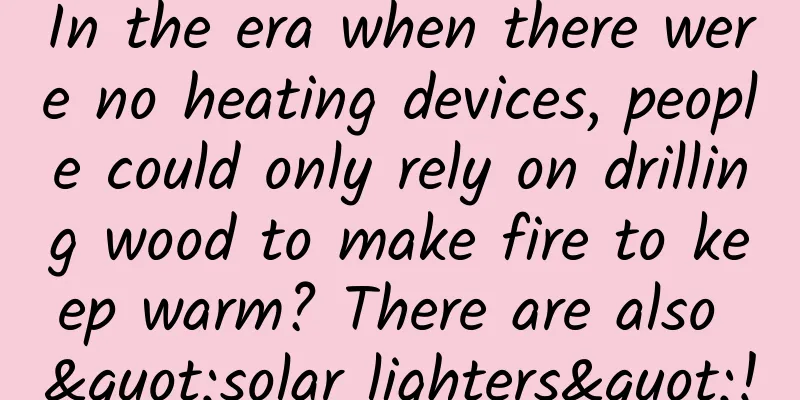In the era when there were no heating devices, people could only rely on drilling wood to make fire to keep warm? There are also "solar lighters"!

|
It's been really cold these days! We all feel cold even with heaters, air conditioners, and electric blankets. How did people keep warm in the days without these heating devices? Many people's first reaction is to "make fire by rubbing two sticks together." Don't be outdated, in fact, people have long used "solar lighters"! 1 Was the legend of “making fire with a wood flint” an accident? According to legend, there was a country called Suiming in ancient times. There grew a huge fire tree called "Suimu", which was always burning with blazing flames, illuminating Suiming country day and night. Later, a wise man from the Central Plains traveled here. When he was resting under the Suimu, a divine bird that looked like an owl flew to the tree and pecked out clusters of flames with its beak. The wise man suddenly realized that there was fire hidden in the wood! So he used branches to experiment several times and finally invented the method of drilling wood to make fire. After returning to the Central Plains, he taught this method everywhere and was honored as "Suirenshi". The method of drilling wood to make fire is also called "wood-sui fire". Emperor Sui's Mausoleum in Shangqiu City, Henan Province (Photo source: Visual China) Although the story of Suirenshi is just a myth, it also implies how our ancestors learned to make fire artificially from preserving natural fire. The history of ancient people using fire is very long, even longer than "human beings" themselves - scholars have found that our closest relatives, chimpanzees, can already observe and use wildfires in nature. Archaeological discoveries of ancient human fire remains can be as early as millions of years. However, these remains are mostly suspected to be natural fires, because the Neanderthals who separated from us about 800,000 years ago left behind very strange remains of fire: they used a lot of fire in the early warm period, but almost did not use fire in the later cold period . Considering that there are often frequent lightning in warm periods, but very few lightning in cold periods, scientists speculate that Neanderthals did not know how to make fire, but relied on natural fire left by lightning. According to legend, Suirenshi saw the divine bird pecking at wood to make fire. Maybe the prototype of the story was the wood struck by lightning? An imaginary picture of a Neanderthal settlement (Source: Visual China) By this calculation, humans learned to make fire within 800,000 years. Some scholars even speculate that it was less than 100,000 years ago, when the ancestors accidentally discovered the bowstring method of drilling holes in wood. In addition, humans are not immune to the various carcinogens produced by barbecue, which also suggests that humans should have used fire to roast food very recently, so that our bodies have not had time to evolve and adapt . However, humans are born to like cooked and hot food. Considering that there are hot springs everywhere in the Great Rift Valley of East Africa, perhaps our ancestors have been using hot springs to cook food before leaving Africa? Beijing Fangshan Zhoukoudian Site Museum Collection: "Peking Man" using fire (Photo source: Visual China) Using a bowstring to drill holes in wood to make fire (Image source: Visual China) In any case, humans must have mastered the method of drilling wood to make fire by 40,000 years ago at the latest . However, the actual operation was still difficult: the wood planks and wood drills for making fire were inconvenient to carry, and it was difficult to make fire anytime and anywhere; drilling wood also required considerable skills and physical strength. Therefore, for a long time, it was still the habit of our ancestors to try to preserve the fire as much as possible to reduce the need to re-start the fire. Fortunately, in the pre-Qin period, the "Yang Sui" was invented, and people were able to carry fire-making tools with them and make fire on the spot. 2 Yangsui fire-making: the beginning of the era of portable fire Yangsui looks a lot like a bronze mirror, but unlike the smooth surface of a mirror, the mirror surface of Yangsui is concave, thin in the middle and thick at the edges, which can focus the reflected sunlight on one point. If you place flammable flammable materials such as moxa at the focus of the sunlight, it can be ignited in a few seconds. In the "Ancient and Modern Notes" written by Cui Bao of the Jin Dynasty, it is recorded: "Yangsui is made of copper, shaped like a mirror, reflecting objects, the image is inverted, facing the sun, fire will be generated, and moxa sticks will produce fire" - not only detailed the texture, appearance and usage of Yangsui, but also observed that the image formed by a concave mirror is an inverted virtual image. A bronze concave mirror unearthed from Tomb No. 60 of the Western Zhou Dynasty in Huangdui, Fufeng, Shaanxi in 1995. The upper picture shows the back, and the lower picture shows the side. It was identified as a Yangsui (Image source: Screenshot of the paper) In fact, modern solar cookers also use the same principle. The Olympic flame is still made with the Yangsui method. In the past, ancient people often wore Yangsui around their waists for use when they went out. It was simply the "solar lighter" of the ancients. In the Eastern Han Dynasty, Yangsui was also used as a token of marriage, representing the success of a family. On April 21, 2016, the Rio Olympics successfully lit the Olympic flame in Ancient Olympia, the birthplace of the Olympics on the Peloponnese Peninsula in Greece. The Olympic flame has always been lit using the sun-flint method (Photo source: Xinhua News Agency) However, Yangsui cannot be used to make fire when it is cloudy or at night, so it coexisted with other ways of making fire for a long time . For example, the ancient method of drilling wood to make fire was still popular from the Zhou Dynasty to the Han Dynasty, and different woods were used to make fire throughout the year. The ancient book "Book of Zhou·Monthly Orders" records: "In spring, use the fire of elm and willow, in summer, use the fire of jujube and apricot, in late summer, use the fire of mulberry and jujube, in autumn, use the fire of oak and oak, and in winter, use the fire of locust and sandalwood." Every time the season changes, it is necessary to "extinguish the fire", replace it with more suitable wood according to the season, and obtain fire again by "drilling wood to make fire". This practice was later called "changing fire" or "changing fire", which may even be the source of the later Cold Food Festival and Tomb-Sweeping Day: "Zhou Li·Qiu Guan Si Kou·Si Li" records: "Si Xuanshi, in charge of using flint to make bright fire in the sun... All major events of the state, tomb candles and courtyard fires. In mid-spring, a fire ban is established in the country with a wooden bell." That is to say, in the Zhou Dynasty, there was an official in charge of making fire called "Si Xuanshi". He was responsible for using the sun flint to make fire and providing fire for tomb candles and courtyard fires in national ceremonies. In mid-spring, a fire ban was announced in the country by knocking a wooden bell. Probably in the Han Dynasty, the combination of changing the fire in spring and summer and the mid-spring fire ban gave rise to the first cold food . The name of cold food also came from this: you can't cook or heat dishes, so you can only eat cold food. The motivation for combining the two is easy to understand: extinguishing the fire during the fire ban, and then replacing new flint to make fire again, giving people a feeling of renewal . However, after the end of mid-spring comes late spring, and after the end of late spring comes early summer. If the fire is extinguished at the end of mid-spring, it will take a whole month until the beginning of summer. Wouldn't it be a month without being able to make fire to cook or boil water for bathing? Cold Food Festival (Photo source: Visual China) So at the end of the Han Dynasty, Cao Cao could no longer tolerate it and issued a "Punishment Order" to cancel the Cold Food Festival: "I heard that Taiyuan, Shangdang, Xihe, and Yanmen all stopped burning and ate cold food 150 days after the winter solstice. It is said that it was for Jie Zitui. Zixu drowned in the river, but the people of Wu did not stop drinking water. Isn't it unfair to only eat cold food for Zitui? Moreover, the north is a cold place, and the old and young are weak, and they will be in danger. After the order is issued, people are not allowed to eat cold food. If anyone violates it, the head of the family will be sentenced to half a year in prison, the chief clerk will be sentenced to 100 days in prison, and the chief will have one month's salary taken away." The ban is too harsh to punish a person to spend half a year in jail for celebrating a festival. The ban also says that the origin of Cold Food Festival is from Jie Zitui, a loyal minister of the State of Jin during the Spring and Autumn Period. Legend has it that he was burned to death on this day, and the people of Jin did not light a fire for a month to commemorate him. Cao Cao also complained in the ban: Wu Zixu died by drowning, and I have never seen anyone not touching water for a month. Aren’t you too biased? In fact, commemorating Jie Zitui is just a folk legend. According to Eastern Zhou historical records, Jie Zitui lived in seclusion until his death and was not burned to death, so there is no question of banning fire to commemorate him. However, Cao Cao's ban did not last long. After Cao Wei was replaced by Sima Jin, perhaps out of goodwill for the same country name, Cold Food Festival was revived again and promoted throughout the country. 3. The flint-fire method: the collision of iron and stone It was also no later than the Wei and Jin Dynasties that the ancients invented a "stone flint" method of making fire, which was to use iron pieces to collide with flint to make fire. The flint used is also called flint, which is a hard phosphorus-containing silicon stone. After colliding with iron, it will burst out sparks, which is called "stone fire". Bai Juyi, a great poet in the Tang Dynasty, wrote the famous sentence "What is the matter with the snail's horn? I live in the light of stone fire", lamenting that life is as short as the sparks emitted by flint. Flint is easy to carry and it is also very quick to make fire. Just pull out a knife and scrape it. Therefore, stone flint soon became the most mainstream way of making fire in ancient China after the Southern and Northern Dynasties. The Tang people would also wrap the flint in a small cloth and hang it on their belts. Even officials had to wear it when they went to court, otherwise it would be impolite. After the rise of stone flints, wooden flints basically disappeared, but the sun flints were still popular for a while. In the Song and Ming dynasties, there was a two-sided bronze mirror: one side was flat and could be used to reflect people; the other side was concave and could be used to make fire. At the same time, in China during the Song and Ming dynasties, the world's earliest matches were born. Tao Gu, a Northern Song Dynasty man, mentioned in his book "Qingyi Lu" that at that time, there were smart people who soaked pine wood strips with sulfur and stored them for future use. As long as there was a little spark, the small wooden strips could be quickly ignited. This small wooden strip is also called "Yinguangnu", and its craftsmanship is very close to today's matches. Unfortunately, the Yang Sui was basically lost in the Qing Dynasty. Even when people in the Qing Dynasty read ancient books, they would question the existence of the Yang Sui, believing that it was impossible to make fire with a bronze mirror. The method of making fire with stone flints continued to improve. Later flintlock guns and lighters were upgraded from the principle of making fire with stone flints. From then on, the method of making fire entered the modern era. Author: Liu Fu, popular science creator Reviewer: Wang Yang, Associate Professor, Department of Archaeology, Wuhan University Produced by: Science Popularization China Produced by: China Science and Technology Press Co., Ltd., China Science and Technology Publishing House (Beijing) Digital Media Co., Ltd. |
>>: Let's take pictures of the sun's poles! AI neural network reconstructs the sun in 3D
Recommend
What is the value of B-side designers? Let’s take a look at the director-level analysis (Part 1)
Where does the value of B-side designers come fro...
Details of ZUK phone revealed, is it going to be an Android version of iPhone?
"If the ZUK phone and the next generation iP...
During the Spring Festival, children must be protected from the safety hazards of fireworks and firecrackers!
Fireworks and firecrackers often cause injuries d...
Evaluation of the effectiveness of Xiaohongshu advertising!
What do you think about whether Xiaohongshu adver...
Android open source time selection control
Source code introduction A powerful time selectio...
How much do you know about facial recognition?
In recent years, with the rapid development of ar...
Case analysis: Techniques for attracting new customers through paid content!
Since 2016, the concept of "micro-course&quo...
Recommend two iOS magnetic download tools
When it comes to magnetic download tools, the fir...
Double 11 Sale: Are Things Really Cheaper?
Yesterday, the Beijing Industry and Commerce Bure...
Today, let us pay tribute to them together!
END Tadpole five-line score original work, please...
How to add official Android app to the market? How to add official labels to major Android markets!
Many people are asking how to add an “official” l...
Landing page optimization method!
Looking at today's marketing situation, brand...
Sina Fuyi Mobile Game Industry Launch Strategy
The mobile game market seems to be booming, but m...
Event operation: How to attract new customers at zero cost?
Today I would like to share with you a growth act...
New Zealand announces suspension of extradition treaty with Hong Kong (attached with original text)
New Zealand announces suspension of extradition t...









